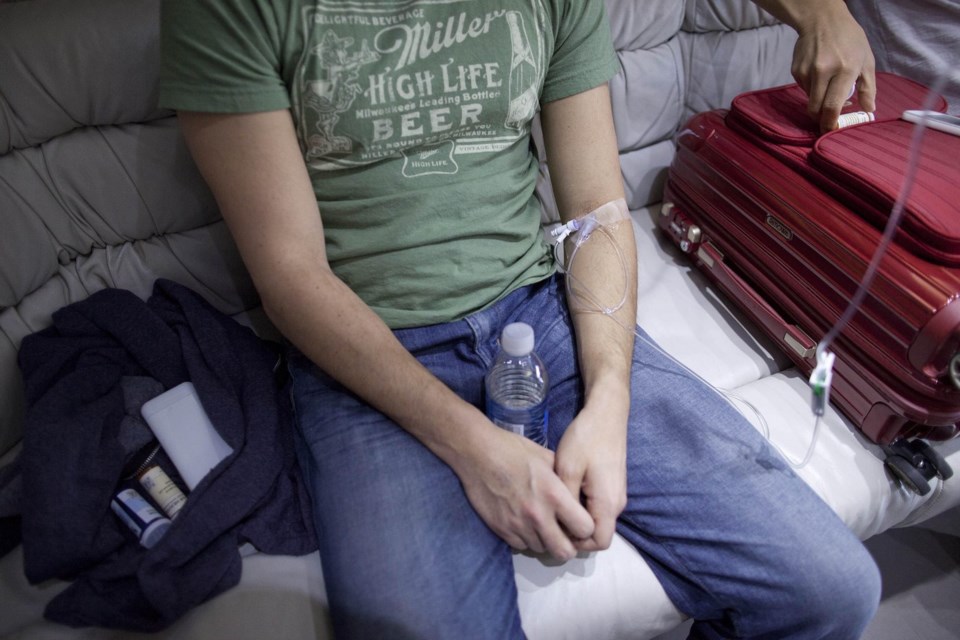IV therapy clinics are springing up around the country, touting quick ways to recover from a hangover or a hard workout. But doctors and regulators preach caution.
The services have been on a growth spurt since the COVID-19 pandemic, offering drips that promise to boost energy, gird immune systems or relieve joint pain. This is done from bags of intravenous fluids normally seen hanging next to hospital beds.
Customers must be willing to fork over as much as couple hundred dollars for each session — in some cases for a mixture of vitamins and supplements that would be considerably cheaper in pill form.
Proponents say this approach helps customers hydrate faster and absorb more of a vitamin or supplement than they would by swallowing pills.
But Dr. Sam Torbati, co-chair of emergency medicine at Cedars-Sinai Medical Center in Los Angeles, says the therapy mostly helps people create “expensive urine,” with the body clearing what it doesn't use.
How many IV clinics are there?
They’re hard to count, partly because some businesses just provide IV therapy while others offer it as part of a medical spa.
The practice grew popular during COVID-19, when access to doctors became limited and people grew more concerned about their immune system health, according to the American IV Association, an industry group.
Regulators in Ohio are following the trend closely in their state, which now has around 200 clinics. These businesses were largely unheard of there before the pandemic, said Cameron McNamee, a spokesman for the Ohio Board of Pharmacy.
What should customers know about IV therapy clinics?
Doctors say there are some good questions to pose before any treatment starts.
Customers should ask the person starting the IV how long they have been doing their job and what sort of training they have, said Torbati.
They also should know what’s in the IV drip. For instance, “Wonder Juice” treatment offered by the Restore Hyper Wellness franchise combines six vitamins and supplements that are available, in oral form, on the pharmacy store shelves.
Knowing all the ingredients comes in handy if someone has an allergic reaction.
Also ask where the company gets its drugs, if any are used. The answer should be a licensed pharmaceutical wholesaler, according to McNamee.
Otherwise, the drug could be counterfeit or substandard. Ohio regulators have suspended the licenses of businesses that purchased drugs on Facebook.
Customers also should make sure the clinic is in decent shape when they visit.
“If the office isn’t clean, then the IV room’s probably not clean either,” McNamee said.
Why are regulators concerned?
They don’t like that a nurse or a paramedic often helps a customer decide on an IV therapy and then delivers the treatment. Rules can vary, but many state regulators say a doctor, physician assistant or nurse practitioner should be involved.
The clinics often run on standing orders, which are issued by a doctor with the idea that they give the nurse or paramedic permission to treat patients according to certain protocols.
Hospital emergency rooms regularly operate on the same kind of orders, according to Dr. Chris Seitz, an emergency physician and chairman of the American IV Association's scientific advisory board.
“Many nurses saw patients before I ever could get to them in the emergency department and initiated care like IV fluids,” he said.
Is there too much patient involvement?
Regulators also worry about the role customers play in picking their own treatments.
“A patient cannot enter a doctor’s office or hospital and demand an IV any more than a patient can direct his or her own appendectomy,” Kentucky officials said in a March statement.
But Seitz says there should be a partnership between any care provider and the patient, with the provider helping the patient make the right decision.
“Patients have a requirement and a need to be the CEO of their own health,” he said.
Patient choice feeds another worry: the mixing of ingredients for specific treatments, a practice known as compounding.
South Carolina regulators said in a 2023 statement that this should result from a valid care provider order, “not from a patient-driven menu akin to a fast-food restaurant.”
However, proponents say the addition of vitamins or drugs to an IV treatment should not be confused with mixing prescription drugs in a lab.
“It’s just pretty simple low-hanging fruit in terms of clinical complexity,” said Jeff Cohen, a co-founder of the American IV Association.
What’s the big picture?
IV therapy clinics do provide some care. They can help cancer patients or pregnant women stay hydrated. Some treatments offer relief from migraine pain.
But many drips require the creation of a sterile, soluble vitamin or supplement that is safe to put into someone's veins. That's more expensive to make than a vitamin that may cost a few cents a pill, Torbati noted.
Customers will need to determine whether the added expense is worth it.
“Usually within eight hours, all that expensive therapy (is) peed out,” he said.
___
The Associated Press Health and Science Department receives support from the Howard Hughes Medical Institute’s Science and Educational Media Group. The AP is solely responsible for all content.
Tom Murphy, The Associated Press



